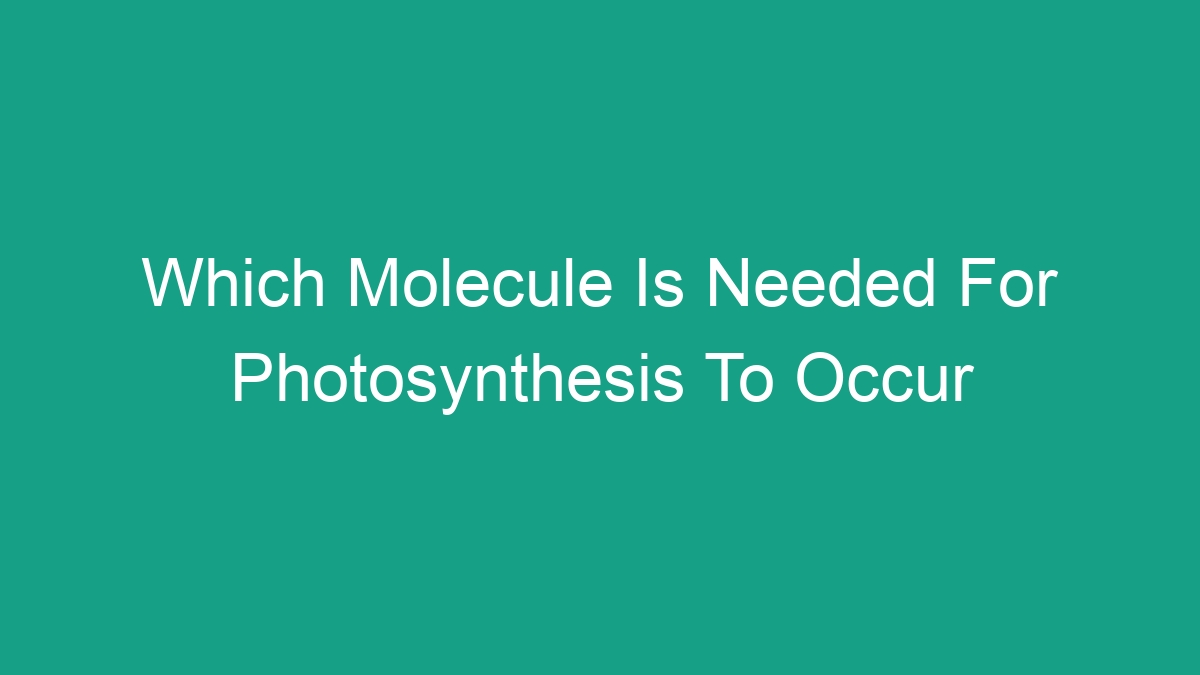
Photosynthesis is a crucial process for life on Earth as it is the method through which green plants and other organisms convert light energy into chemical energy. This energy is then stored in the form of glucose, which serves as the primary source of energy for all living things. One of the key components of photosynthesis is the presence of specific molecules that enable the process to occur. In this article, we will explore the molecule needed for photosynthesis to occur and its role in this vital biological process.
The Molecule Needed for Photosynthesis
Photosynthesis requires several key molecules to take place, including water, carbon dioxide, and sunlight. However, the molecule specifically needed for photosynthesis to occur is chlorophyll. Chlorophyll is a pigment that gives plants their green color and plays a critical role in capturing light energy during the light-dependent reactions of photosynthesis.
Chlorophyll is a complex molecule that is primarily found in the thylakoid membranes of chloroplasts, the organelles responsible for photosynthesis in plant cells. This molecule is essential for the absorption of light energy, which is then used to convert carbon dioxide and water into glucose and oxygen.
The Role of Chlorophyll in Photosynthesis
Chlorophyll is crucial for the process of photosynthesis as it serves several essential functions, including:
- Absorbing Light Energy: Chlorophyll molecules are specifically structured to absorb light in the visible spectrum, particularly in the red and blue wavelengths. This absorbed light energy is then used to power the photosynthetic reactions that convert carbon dioxide and water into glucose and oxygen.
- Initiating Electron Transport: When chlorophyll molecules absorb light energy, they initiate a series of complex reactions in the thylakoid membranes known as the light-dependent reactions. These reactions involve the movement of electrons through a series of proteins, ultimately producing energy-rich molecules such as ATP and NADPH that are used in the subsequent stages of photosynthesis.
- Splitting Water Molecules: In addition to capturing light energy, chlorophyll molecules also play a critical role in the photolysis of water. This process involves the splitting of water molecules into oxygen, protons (H+), and electrons, which release oxygen as a byproduct and provide the electrons needed to fuel the photosynthetic electron transport chain.
As such, chlorophyll is indispensable for the efficient capture and utilization of light energy, making it a fundamental molecule for the process of photosynthesis to occur.
Types of Chlorophyll Molecules
There are several types of chlorophyll molecules, each with specific variations in their chemical structure and light-absorption properties. The most common types of chlorophyll found in plants are chlorophyll a and chlorophyll b:
- Chlorophyll a: This is the primary form of chlorophyll found in plants and is directly involved in the light-dependent reactions of photosynthesis. It absorbs light most effectively in the red and violet-blue parts of the spectrum, reflecting green light and giving plants their characteristic green color.
- Chlorophyll b: This form of chlorophyll complements the light-absorption spectrum of chlorophyll a by capturing light energy in the blue and orange parts of the spectrum. It transfers this energy to chlorophyll a and expands the range of wavelengths that can be utilized for photosynthesis.
Both chlorophyll a and chlorophyll b work in concert to maximize the absorption of light energy and drive the essential reactions of photosynthesis. The presence of these chlorophyll molecules is critical for the efficient conversion of light into chemical energy within plant cells.
Other Molecules Involved in Photosynthesis
In addition to chlorophyll, several other molecules play important roles in the process of photosynthesis. These include:
- Carbon Dioxide (CO2): This is a critical reactant in the Calvin cycle, the series of chemical reactions that convert carbon dioxide and other compounds into glucose. Carbon dioxide is absorbed from the atmosphere and enters the chloroplasts, where it is utilized in the dark reactions of photosynthesis.
- Water (H2O): Water molecules are split during the light-dependent reactions, releasing oxygen, protons, and electrons. The oxygen is released as a byproduct, while the electrons are used to drive the production of ATP and NADPH, which are essential for the synthesis of glucose in the Calvin cycle.
Together, these molecules, along with chlorophyll, facilitate the complex series of reactions that make up the process of photosynthesis, allowing green plants to convert light energy into the chemical energy stored in glucose.
FAQs (Frequently Asked Questions)
Here are some common questions related to the molecule needed for photosynthesis to occur:
Q: Can photosynthesis occur without chlorophyll?
A: No, photosynthesis cannot occur without chlorophyll. Chlorophyll is specifically designed to absorb light energy, initiating the reactions that convert carbon dioxide and water into glucose and oxygen. Without chlorophyll, plants would be unable to capture and utilize light energy for the process of photosynthesis.
Q: Are there other pigments involved in photosynthesis?
A: Yes, apart from chlorophyll, other pigments such as carotenoids and phycobilins may also be present in certain organisms. These pigments serve to broaden the spectrum of light absorption and provide additional protection against excess light energy. However, chlorophyll remains the primary pigment responsible for capturing light energy during photosynthesis.
Q: What happens if there is a shortage of chlorophyll in plants?
A: A shortage of chlorophyll in plants can result in reduced photosynthetic activity, leading to stunted growth, yellowing of leaves (a condition known as chlorosis), and overall decreased plant health. Ensuring an adequate supply of chlorophyll is vital for the efficient functioning of photosynthesis and the overall well-being of plants.
In conclusion, chlorophyll is the primary molecule needed for photosynthesis to occur. Its ability to capture light energy and drive the essential reactions of photosynthesis makes it an indispensable component of this vital biological process.



